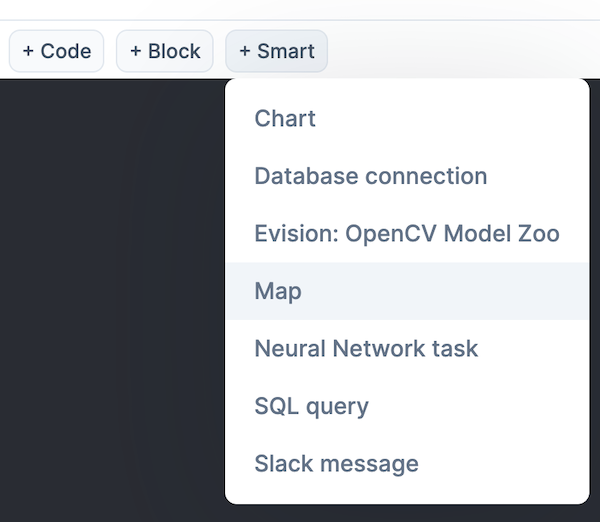はじめに
皆さん、お米食べてますか?
美味しいお米を生産してくれる田んぼは日本の宝です
というわけで、今回は農林水産省の筆(ふで)ポリゴンデータを使って、田んぼや畑を地図上にプロットしていきます
ちなみに、「筆」は登記するときの土地の単位です
例によって可視化には Elixir Livebook を使います
手軽に綺麗な可視化ができるからです
実装したノートブックはこちら
出典
「筆ポリゴンデータ(2022年度公開)」(農林水産省)(https://www.maff.go.jp/j/tokei/porigon/)を加工して作成
参考サイト
宙畑の Python 実装を参考にしています
「衛星データ利用環境整備・ソリューション開発支援事業」
この記事は経済産業省の「衛星データ利用環境整備・ソリューション開発支援事業」に関連して、衛星データを Elixir で処理する方法を研究するために書いています
近日、本記事で扱う地理情報と、 Tellus から取得する衛星データの紐付けについて記事を投稿します
実行環境
- macOS Ventura 13.1
- Rancher Desktop 1.7.0
Livebook 0.8.0 の Docker イメージを元にしたコンテナで動かしました
コンテナ定義はこちらを参照
セットアップ
Livebook のセットアップセル(先頭のセル)に以下を入力して実行します
Mix.install(
[
{:nx, "~> 0.4"},
{:evision, "~> 0.1"},
{:exla, "~> 0.4"},
{:geo, "~> 3.4"},
{:jason, "~> 1.4"},
{:kino, "~> 0.8"},
{:kino_maplibre, "~> 0.1.3"}
],
config: [
nx: [
default_backend: EXLA.Backend
]
]
)
以下の依存モジュールをインストールしています
- Nx: 行列演算
- Evision: 画像処理
- EXLA: 行列演算の高速化
- Geo: 地理情報システム
- Jason: JSONパーサー
- Kino: Livebook での入出力
- Kino MapLibre: 地図出力
また、 Nx による行列演算を EXLA を使って高速化する設定をしています
筆ポリゴンデータのダウンロード
筆ポリゴン公開サイトから画面下部の「筆ポリゴンデータダウンロードページ」のボタンをクリックします
表示されるアンケートに回答します
遷移先のダウンロードページで公開年度、都道府県、市区町村を選択し、「ダウンロード」をクリックします
ダウンロードした ZIP ファイルを展開します
今回は大分県大分市 2022 年度のデータを /tmp/2022_442011.json に展開したものとして進めます
拡張子は単に .json ですが、中身は GeoJSON になっています
GeoJSON は地理情報を JSON 形式で表現するための形式です
Elixir では Geo モジュールを使うことで扱いやすくすることができます
GeoJSON の読込
json ファイルを開いて見ましょう
geojson_data =
json_file
|> File.read!()
|> Jason.decode!()
|> Geo.JSON.decode!()
パースした結果は以下のような形式になっています
データの仕様はこちら
%Geo.GeometryCollection{
geometries: [
# 田畑の地理情報
%Geo.Polygon{
coordinates: [
# 一つのポリゴン
[
[
{<経度>, <緯度>},
{<経度>, <緯度>},
{<経度>, <緯度>},
...
]
]
],
srid: nil,
properties: %{
"edit_year" => <調製年度>,
"history" => <履歴>,
"issue_year" => <公開年度>,
"land_type" => <耕地の種類:地目コード(100:田、200:畑)>,
"last_polygon_uuid" => <前年筆ポリゴンID>,
"local_government_cd" => <地方公共団体コード>,
"point_lat" => <重心点座標緯度>,
"point_lng" => <重心点座標経度>,
"polygon_uuid" => <筆ポリゴンID>,
"prev_last_polygon_uuid" => <前前年筆ポリゴンID>
}
},
%Geo.Polygon{
...
地理情報は、このように緯度と経度で表される地球上の点を複数列挙し、その点を結ぶ多角形(ポリゴン)で表現されます
Enum.count(geojson_data.geometries)
件数をカウントしてみます
64,400 件ありました
田んぼだけだと 37,817 件
geojson_data.geometries
|> Enum.filter(& &1.properties["land_type"] == 100)
|> Enum.count()
畑だけだと 26,583 件
# 畑の件数
geojson_data.geometries
|> Enum.filter(& &1.properties["land_type"] == 200)
|> Enum.count()
件数が大きすぎるため、緯度経度で絞り込みます
target_fields =
geojson_data.geometries
|> Enum.filter(fn field ->
field.properties["point_lng"] >= 131.42 &&
field.properties["point_lng"] <= 131.46 &&
field.properties["point_lat"] >= 33.13 &&
field.properties["point_lat"] <= 33.15 &&
field.properties["land_type"] == 100
end)
|> then(fn geometries ->
%Geo.GeometryCollection{geometries: geometries}
end)
Enum.count(target_fields.geometries)
Smart Cell による可視化
Livebook ではこの GeoJSON データを Smart Cell に渡すだけで簡単に可視化できます
セルを追加するときに +Smart を開き、 Map を選択します
追加された Smart Cell に値を指定します
- MAP STYLE: terrain(non-commercial)
- CENTER: 131.443, 33.131
- ZOOM: 16
- Source: target_fields
- Type: line
セルを実行すると、航空写真の地図上に田んぼの形が表示されます
この地図はズームしたり表示範囲を動かしたり、対話的(インタラクティブ)に動作します
この黒い線の折れている点全ての座標が GeoJSON の中に書かれているわけです
Smart Cell を使わない可視化
Smart Cell を使わず、最初から当該区域を中心にズームして、田んぼを塗りつぶしてみましょう
中心座標を取得します
longitudes =
target_fields.geometries
|> Enum.map(& &1.coordinates)
|> List.flatten()
|> Enum.map(&elem(&1, 0))
latitudes =
target_fields.geometries
|> Enum.map(& &1.coordinates)
|> List.flatten()
|> Enum.map(&elem(&1, 1))
center = {
(Enum.min(longitudes) + Enum.max(longitudes)) / 2,
(Enum.min(latitudes) + Enum.max(latitudes)) / 2
}
MapLibre に GeoJSON を渡してプロパティを指定し、可視化します
MapLibre.new(center: center, zoom: 14.5, style: :terrain)
|> MapLibre.add_geo_source("geojson", target_fields)
|> MapLibre.add_layer(
id: "fill",
source: "geojson",
type: :fill,
# 半透明の緑にする
paint: [fill_color: "#00ff00", fill_opacity: 0.5]
)
Evision による可視化
では Evision を使って、この多角形を画像データにしてみましょう
まず、対象区域の端の緯度経度を取得します
# 緯度経度の最大最小を求める
coordinates =
target_fields.geometries
|> Enum.map(& &1.coordinates)
|> List.flatten()
longitudes = Enum.map(coordinates, &elem(&1, 0))
latitudes = Enum.map(coordinates, &elem(&1, 1))
min_longitude = Enum.min(longitudes)
max_longitude = Enum.max(longitudes)
min_latitude = Enum.min(latitudes)
max_latitude = Enum.max(latitudes)
{min_longitude, max_longitude, min_latitude, max_latitude}
画像にするときのサイズを指定します
{height, width} = {1280, 2560}
緯度経度の最小から最大をピクセル数の0から幅・高さに正規化します
大分県の場合は以下のようになります
- 横方向:
- 正規化前: 131.435353795 から 131.460065396
- 正規化後: 0 から 1280
- 縦方向:
- 正規化前: 33.135901549 から 33.129839302
- 正規化後: 0 から 2560
縦方向は北緯なので大小が逆転します
normalized_points =
target_fields.geometries
|> Enum.map(& &1.coordinates)
|> Enum.map(fn coordinate ->
coordinate
|> Enum.at(0)
|> Enum.map(fn {x, y} ->
[
trunc((x - min_longitude) * width / (max_longitude - min_longitude)),
# 縦方向は緯度が北緯の場合逆転するため、高さから引く
trunc(height - (y - min_latitude) * height / (max_latitude - min_latitude))
]
end)
|> Nx.tensor(type: :s32)
end)
多角形を描画するための空画像を用意します
透明度を使うため、 BGRA の4つに 0 を指定します
# 全て黒の不透明
empty_mat =
[0, 0, 0, 255]
|> Nx.tensor(type: :u8)
|> Nx.tile([height, width, 1])
|> Evision.Mat.from_nx_2d()
Evision.fillPoly に元画像、多角形の配列、色を渡すことで画像に多角形を描画できます
img = Evision.fillPoly(empty_mat, normalized_points, {0, 0, 0, 0})
縦 1280 ピクセル、横 2560 ピクセルに田んぼの形を多角形として表現できました
白いところは透明になっています
これを地図上にプロットしてみます
画像を地図にプロットするため、 BASE64 にします
img_base64 =
Evision.imencode(".png", img)
|> Base.encode64()
|> then(&"data:image/png;base64,#{&1}")
MapLibre.new(center: center, zoom: 14.5, style: :terrain)
# 画像をレイヤーとして地図に重ねる
|> MapLibre.add_source(
"field_mask",
type: :image,
url: img_base64,
coordinates: [
[min_longitude, max_latitude],
[max_longitude, max_latitude],
[max_longitude, min_latitude],
[min_longitude, min_latitude]
]
)
|> MapLibre.add_layer(
id: "overlay",
source: "field_mask",
type: :raster,
layout: %{
"visibility" => "visible"
}
)
まとめ
画像データ化できた筆ポリゴンデータに衛星データから計算した植生(どれくらい植物が生えているか)を重ねることで、田畑の栽培状況を見ることができます
別のオープンデータを使えば都道府県や市区町村も地図上にプロットできます








